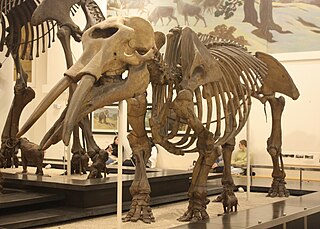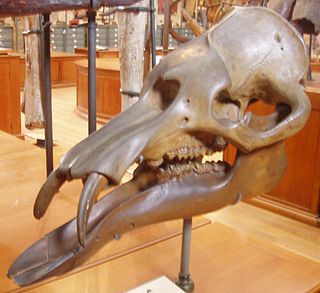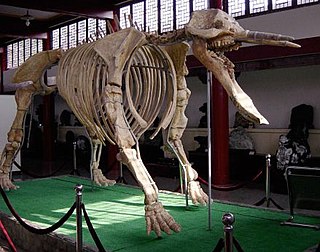
Proboscidea is a taxonomic order of afrotherian mammals containing one living family (Elephantidae) and several extinct families. First described by J. Illiger in 1811, it encompasses the elephants and their close relatives. Proboscideans include some of the largest known land mammals. The largest land mammal of all time may have been a proboscidean; the elephant Palaeoloxodon namadicus has been estimated to be up to 5.2 m (17.1 ft) at the shoulder and may have weighed up to 22 t, surpassing the paraceratheres, the otherwise largest known land mammals, though this estimate was made based on a single fragmentary femur and is speculative. The largest extant proboscidean is the African bush elephant, with a record of size of 4 m (13.1 ft) at the shoulder and 10.4 t. In addition to their enormous size, later proboscideans are distinguished by tusks and long, muscular trunks, which were less developed or absent in early proboscideans.

A mastodon is a member of the genus Mammut, which strictly defined, was endemic to North America and lived from the late Miocene to the early Holocene. Mastodons belong to the order Proboscidea, the same order as elephants and mammoths. Mammut is the type genus of the extinct family Mammutidae, which diverged from the ancestors of modern elephants at least 25 million years ago, during the Oligocene.

Mammutidae is an extinct family of proboscideans belonging to Elephantimorpha. It is best known for the mastodons, which inhabited North America from the Late Miocene until their extinction at beginning of the Holocene, around 11,000 years ago. The earliest fossils of the group are known from the Late Oligocene of Africa, around 24 million years ago, and fossils of the group have also been found across Eurasia. The name "mastodon" derives from Greek, μαστός "nipple" and ὀδούς "tooth", referring to their characteristic teeth.

Platybelodon is an extinct genus of large herbivorous proboscidean mammals related to modern-day elephants, placed in the "shovel tusker" family Amebelodontidae. Species lived during the middle Miocene Epoch in Africa, Asia and the Caucasus.

Amebelodon is a genus of extinct proboscidean belonging to Amebelodontidae. The most striking attribute of this animal is its lower tusks, which are narrow, elongated, and distinctly flattened with the degree of flattening varying among the different species. One valid species is known for this genus, which was endemic to North America. Other species once assigned to Amebelodon are now assigned to the genus Konobelodon, which was once a subgenus.

Gomphotheres are an extinct group of proboscideans related to modern elephants. They were widespread across Afro-Eurasia and North America during the Miocene and Pliocene epochs and dispersed into South America during the Pleistocene as part of the Great American Interchange. Gomphotheres are a paraphyletic group that is ancestral to Elephantidae, which contains modern elephants, as well as Stegodontidae. While most famous forms such as Gomphotherium had long lower jaws with tusks, which is the ancestral condition for the group, some later members developed shortened (brevirostrine) lower jaws with either vestigial or no lower tusks, looking very similar to modern elephants, an example of parallel evolution, which outlasted the long-jawed gomphotheres. By the end of the Early Pleistocene, gomphotheres became extinct in Afro-Eurasia, with the last two genera, Cuvieronius ranging from southern North America to western South America, and Notiomastodon having a wide range over most of South America until the end of the Pleistocene around 12,000 years ago, when they became extinct following the arrival of humans.

Phiomia is an extinct genus of basal elephantiform proboscidean that lived in what is now Northern Africa during the Late Eocene to Early Oligocene some 37–30 million years ago. "Phiomia serridens" means "saw-toothed animal of Faiyum".

Cuvieronius is an extinct New World genus of gomphothere which ranged from southern North America to western South America during the Pleistocene epoch. Among the last gomphotheres, it became extinct at the end of the Pleistocene, approximately 12,000 years ago, following the arrival of humans to the Americas.

Tetralophodon is an extinct genus of "tetralophodont gomphothere" belonging to the superfamily Elephantoidea, known from the Miocene of Afro-Eurasia.
Primelephas is a genus of Elephantinae that existed during the Miocene and Pliocene epochs. The name of the genus suggests 'first elephant'. These primitive elephantids are thought to be the common ancestor of Mammuthus, the mammoths, and the closely allied genera Elephas and Loxodonta, the Asian and African elephants, diverging some 4-6 million years ago. It had four tusks, which is a trait not shared with its descendants, but common in earlier proboscideans. The type species, Primelephas gomphotheroides, was described by Vincent Maglio in 1970, with the specific epithet indicating the fossil specimens were gomphothere-like. Primelephas korotorensis is the only other species to be assigned to the genus. All fossils found of the Primelephas have been found in Africa, primarily in modern day Chad, Tanzania, Kenya, Ethiopia, and Uganda.

Archaeobelodon is an extinct genus of proboscidean of the family Amebelodontidae that lived in Europe and North Africa (Egypt) during the Miocene from 16.9 to 16.0 Ma, living for approximately 0.9 million years.
Gnathabelodon is an extinct genus of gomphothere endemic to North America that includes species that lived during the Middle to Late Miocene.

Eubelodon is an extinct genus of gomphothere which lived in North America during the Miocene Epoch. It contains a single species: Eubelodon morrilli.

Serbelodon is an extinct genus of proboscidean. It had tusks and a trunk. It lived in North America during the Miocene Epoch, and it was closely related to Amebelodon. They had a diet that consisted of C3 plants which include fruits, tree cortex, herbs, and leaves.

Notiomastodon is an extinct genus of gomphothere proboscidean, endemic to South America from the Pleistocene to the beginning of the Holocene. Notiomastodon specimens reached a size similar to that of the modern Asian elephant. Like other brevirostrine gomphotheres such as Cuvieronius and Stegomastodon, Notiomastodon had a shortened lower jaw and lacked lower tusks.

Elephantiformes is a suborder within the order Proboscidea. Members of this group are primitively characterised by the possession of upper tusks, an elongated mandibular symphysis and lower tusks, and the retraction of the facial region of the skull indicative of the development of a trunk. The earliest known member of the group, Dagbatitherium is known from the Eocene (Lutetian) of Togo, which is only known from isolated teeth, while other primitive elephantiforms like Phiomia and Palaeomastodon are known from the Early Oligocene onwards. Phiomia and Palaeomastodon are often collectively referred to as "palaeomastodonts" and assigned to the family Palaeomastodontidae. Most diversity of the group is placed in the subclade Elephantimorpha, which includes mastodons, as well as modern elephants and gomphotheres (Elephantida). It is disputed as to whether Phiomia is closely related to both Mammutidae and Elephantida with Palaeomastodon being more basal, or if Palaeomastodon is closely related to Mammutidae and Phiomia more closely related to Elephantida.

Konobelodon is an extinct genus of amebelodont proboscidean from the Miocene of Africa, Eurasia and North America.

Amebelodontidae is an extinct family of large herbivorous proboscidean mammals related to elephants. They were formerly assigned to Gomphotheriidae, but recent authors consider them a distinct family. They are distinguished from other proboscideans by having flattened lower tusks and very elongate mandibular symphysis. The lower tusks could grow considerable size, with those of Konobelodon reaching 1.61 metres (5.3 ft) in length. Their molar teeth are typically trilophodont, and possessed posttrite conules. In the past, amebelodonts' shovel-like mandibular tusks led to them being portrayed scooping up water plants, however, dental microwear suggests that they were browsers and mixed feeders. The lower tusks have been proposed to have had a variety of functions depending on the species, including stripping bark, cutting through vegetation, as well as possibly digging. They first appeared in Africa during the Early Miocene, and subsequently dispersed into Eurasia and then North America. They became extinct by the beginning of the Pliocene. While some phylogenetic studies have recovered Amebelodontidae as a monophyletic group that forms the sister group to Gomphotheriidae proper, some authors have argued that Amebelodontidae may be polyphyletic, with it being suggested that the shovel-tusked condition arose several times independently within Gomphotheriidae, thus rendering the family invalid.
Eurybelodon is an extinct genus of proboscidean in the family Amebelodontidae. It lived in the Clarendonian age of the Miocene.
Protanancus is an extinct genus of amebelodontid proboscidean from Kenya, Pakistan and Thailand. The genus consists solely of type species P. macinnesi. The generic name is derived from the unrelated Anancus, and the Greek prōtos "first".

















